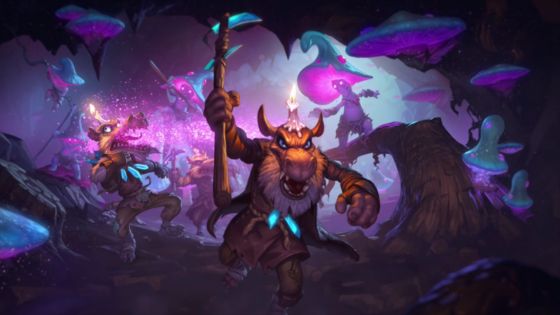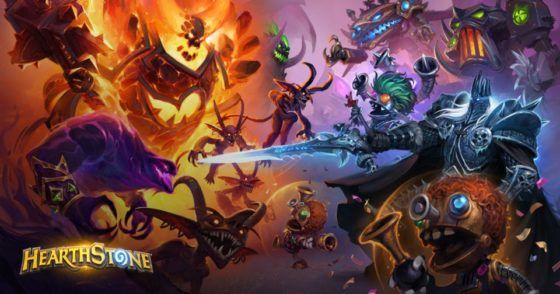World of Warcraft is an EXPANSIVE universe. Azeroth itself is a massive world to live in, with four major continents, three densely populated islands and hundreds of uncharted minor landmasses in the Great Sea. Even stepping beyond the physical world, the universe's cosmology is gigantic in scope and scale. According to the timeline of the lore, a major world ending event has occurred every year for the last NINE years canonically. But despite the major events and the scope of holidays that affect the natives of Warcraft we very rarely see anything minor. While we get flavor texts from time to time, such as the Warrior and his Son in Orgrimmar, we don't often see smaller things or adventures in the world. That is, except for Hearthstone.
For the uninitiated Hearthstone is a collectible card game based on the Warcraft universe. In it players build a deck of cards to battle other players with. They select a particular class, with it's own paragon hero to play as, and combine class cards, monsters and spells with other neutral cards. Many of these cards draw from inspirations in game, such as the Legendary cards about famous characters like Malygos or Tirion. Several others, like the Annoy-O-Tron or Arch-Thief Rafaam, are completely unique to the world.
Hearthstone's lore is one that is constantly in a state of confusion and question; does this game represent a canon aspect of the Warcraft universe? The answer is varied depending on who you ask. As you PLAY as the heroes going through the world's varied adventures, clearly its not canon. Garrosh never fought Arthas in Icecrown Citadel, after all. A spell from Anduin couldn't deal the same damage as Valeera Sanguinar's poisoned daggers, surely. Nothing in many senses surely makes any sense. However, it does also add an extensive bit of lore and reworkings of older lore content.

Previous expansions have created dungeon-run streaks of content throughout the world of Azeroth, drawing distinctly from famous raid expansions in the main game. "Blackrock Mountain," 'Curse of Naxxramas," "Knights of the Frozen Throne," and "One Night in Karazhan," are all clear re-imaginings. While some are more to the point and direct, such as "Curse of Naxxramas," others like "One Night in Karazhan," take that light-hearted Hearthstone flair to romantically retell heroes and stories of the past.
Others, such as "The Grand Tournament," and "League of Explorers" have taken older defunct concepts and brought a new life into them for Hearthstone. After Arthas, the Lich King, was defeated in Icecrown Citadel, the Argent Tournament found itself without much of a future. Originally formed to test potential champions with honorable combat, the organizers from the Argent Crusade found themselves wanting more. Sending invitations all across Azeroth, Hearthstone heroes of all shapes and sizes lined up in troves to become the new Champion of the Argent Tournament. Similarly, the "League of Explorers" breathed life into the static archaeologists guild of the Warcraft universe. Instead it focused on four fresh-faced champions of the League who sought to relieve a rare, powerful artifact from the dastardly grips of Arch-Thief Rafaam.
Each expansion has built up in some manner to the last two years. The Year of the Raven and the Year of the Dragon, decisively, have ventured new lore and content into the otherwise static world of Azeroth's past. While "The Witchwood" explored the Gilnean's push against the dark things in their native home, "The Boomsday Project," took players back to the Netherstorm and the mad scientist Dr. Boom's attempts to 'advance' his chaotic notions of dangerous science. Even, "Rastakhan's Rumble," named after the Zandalari King of the same name, fleshed out an event held "once a generation" to determine a new champion of the Empire.

All of this built up to the Year of the Dragon, the launch of several major story-based expansions all throughout the year. Beginning in April, "Rise of Shadows," saw Arch-Thief Rafaam return as a newly minted Arch-Villain of the Explorer's League. Gathering up other villains of previous expansions, including Blastmaster Boom, he proposed to them a dastardly plan to take over the world itself. The first part of it was simple; All they would need to do is take over the floating mage city of Dalaran...
Joining together, the League of E.V.I.L. swept over Dalaran like a nefarious tide of villainy. With Rafaam at their head, and his goals largely shrouded in secrecy, they managed to dominate the city in one fell swoop. Defeating the Kirin Tor's staunchest defenders, they piloted the floating mage-city directly over the sandy deserts of Uldum. Breaking into ancient tombs with the magical potential of the city, the League came face-to-fin with the League of Explorers who attempted to protect the denizens (and riches!) of the region from Rafaam's gang.
However, even performing their best efforts, the League was ultimately unsuccessful. Breaking into an eldritch tomb, the League of E.V.I.L. managed to secure a potent draught of the Plague of Undeath. Finally he revealed his plan to his cohorts; using the plague he could resurrect and dominate Galakrond, the primordial kin-eater and progenitor of the Dragonflights. Greater than even Deathwing the Destroyer, no one could dare oppose them with Galakron at their beck and call! Now the two leagues find themselves in a battle for the fate of Azeroth itself in the skies high over Dragonblight, where even a drop of undeath could spell the doom of the world.

With that in mind, why is no one in Azeroth talking about this?
On paper, reading this year-long adventure, is an INCREDIBLY exciting turn of events with cataclysmic consequences. Part of that answer, in my humble opinion, falls into both the canonical origins of Hearthstone, and perhaps some of the confusion surrounding its canon.
Hearthstone, like any good tavern game, canonically started in The Inn. Not just any watering hole in the sides-streets of Silvermoon City, but The Inn, a mysterious place that apparently exists between worlds. A place that could exist realistically anywhere in Azeroth. Here time and circumstance bend to fit the story, such as King Magni Bronzebeard arriving for a pint and a few games years after he had been turned into diamonds. It is, as meta-narratives go, incredibly meta beyond normally acceptable tolerances. Perhaps, ideally, that is best how we see the canon potential of Hearthstone itself. Simply meta.
Hearthstone's canon, in my humble opinion, both exists inside the World of Warcraft and does not. It is, in a sense, a meta-narrative retelling of the world's history through stories in the tavern. We are playing as famous heroes of the universe as any other Goblin or Elf would in playing the game. Each expansion pack, each set of new cards and its stories, are a romantic retelling of famous events in the game; while Jaina was never turned into an Arch-Lich, it certainly sounds much cooler than just her being at Icecrown.

Likewise, we get explanations for some of Hearthstone's more canonically confusing elements, such as the "Whispers of the Old Gods," expansion where the three major void villains of Azeroth were active all at once. Likewise, the "Mean Streets of Gadgetzan," is, in part, canonical; from the experiences of the designer, the goblin port town could seem to be a seedy turf-war of gangs and companies!
This, of course, brings us to the Year of the Dragon. Every event across the three expansions we've seen throughout 2019 is perhaps one of Warcraft's little hidden gems. There are heroes, there are villains, there are major stakes where both sides could win or lose everything. At the heart of it all is what Azeroth thrives on in its stories, a major ancient evil just waiting to be awoken. Unlike past expansions, drawing on inspiration or elements from previous events in lore, this is completely new content.
The question should never have been if Hearthstone was canon to the Warcraft universe. It always has been, just from the perspective of our characters. The real question we should be asking is when do we get to see some of its amazing heroes and exciting adventures make their mark on the Azeroth we've come to know and love?